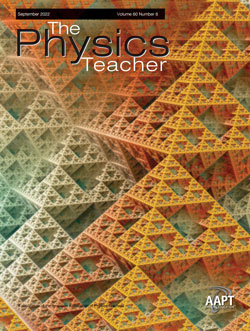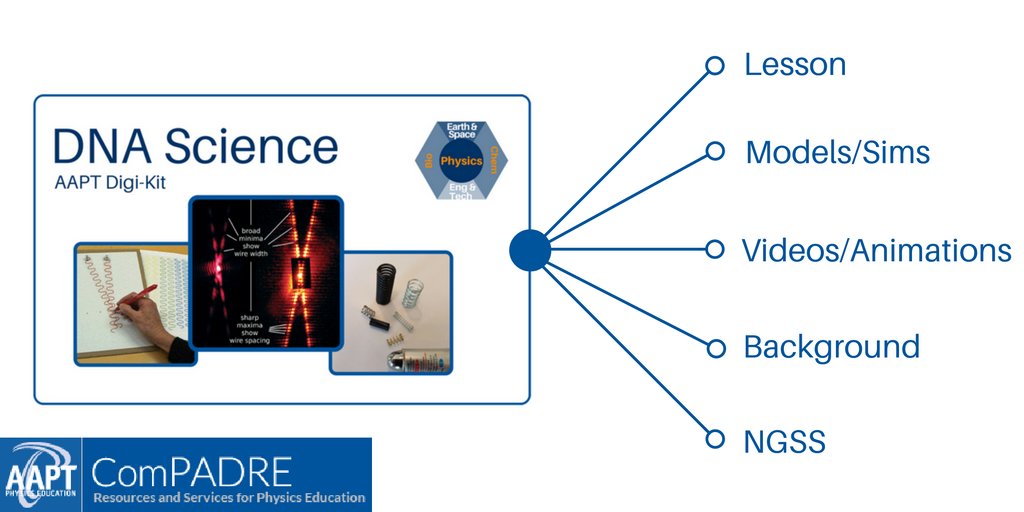
The Physics Teacher
September 2022
Volume 60 Issue 6
Fractals on a Benchtop: Observing Fractal Dimension in a Resistor Network
This Month’s Cover... shows a thought-provoking 3D version of a Sierpinski gasket. In this issue of TPT, we feature a paper by Charles Creffield, “Fractals on a Benchtop: Observing Fractal Dimension in a Resistor Network,” where he details how his students set up resistors in a similar network and mimic fractal resistance effects. See also the appreciation of the wonderful cadre of recent TPT referees. — Gary White
Columns
And the Survey Says..., Astronotes, Figuring Physics, For the New Teacher, Just Physics, iPhysicsLabs, Little Gems, Physics Challenge for Teachers and Students, Fermi Questions, Talkin' Physics, Technology In The Classroom, Tricks of the Trade, Visual Physics, and Websights.
LETTERS TO THE EDITOR
Aristotle’s wheel paradox appreciated by A. James Mallmann. DOI: 10.1119/5.0091101
The Falklands Coriolis story is a myth by Christopher M. Graney. DOI: The Physics Teacher 60, 404 (2022); https://doi.org/10.1119/5.0106008
Erratum: “Physics in James Joyce’s Ulysses,”. DOI: 10.1119/10.0013853
PAPERS
DART: Planetary Defense in the Introductory Physics Curriculum by Joseph C. Amat. DOI: 10.1119/5.0085522
Fractals on a Benchtop: Observing Fractal Dimension in a Resistor Network by Charles Creffield. DOI: 10.1119/5.0054306
Tracking Inequity: An Actionable Approach to Addressing Inequities in Physics Classrooms by Julie Christensen, Niral Shah, Nickolaus Alexander Ortiz, David Stroupe and Daniel L. Reinholz. DOI: 10.1119/5.0044392
Podcasts in Science Classrooms: Storytelling for All Ears! by Sumeet Kulkarni and Brooke A. Whitworth. DOI: 10.1119/5.0038642
All About Polytropic Processes by Randall Knight. DOI: 10.1119/5.0077026
A Flexible, Asynchronous Format for Introductory Physics Laboratory Instruction During the COVID-19 Pandemic by M. A. Antonacci. DOI: 10.1119/5.0064035
Flying Carousel Swing Physics by Andrew Ferstl and Emily R. Duden. DOI: 10.1119/5.0056112
Using Different Smartphone Sensors to Find the Speed of a Toy Car by Serkan Kapucu. DOI: 10.1119/5.0044017
Trajectory Calculations with Lift and DragM/a> Rod Cross. DOI: 10.1119/10.0013855
Analysis of the Propulsion Phase of Water Rockets Using Smartphone Sensors and Video by Analysis Guilherme Frederico Marranghello, Márcia Maria Lucchese and Fábio Saraiva da Rocha. DOI: 10.1119/10.0013856
Analyzing a Free-Falling Magnet to Measure Gravitational Acceleration Using a Smartphone’s Magnetometer by Praveen Pathak and Yogita Patel. DOI: 10.1119/10.0013857
A More Efficient Approach to Demonstrate Hooke’s Law by Yajun Wei and Zhiwei Chong. DOI: 10.1119/5.0043860
Rolling Motion: Augmented Reality Animations and Multiplatform Simulation by Andrej Vidak, Iva Movre Šapić and Mirza Hadžimehmedović. DOI: 10.1119/5.0037214
Exploring to Explain the Marshmallow Phenomenon by Jaclyn Kuspiel Murray. DOI: 10.1119/5.0045288
Open-Source Virtual Labs with Failure-Mode-Inspired Physics and Optics Experiments by Sukmock Lee, Charlotte Guthery, Daewook Kim and Addison Calkins. DOI: 10.1119/5.0056462
Application of Optical Path Drawing Technology: The Light Intensity Problem of Double-Slit Interference by Chun-Ming Chiang, Shih-Hsin Ma, Shou-Tai Lin, Wel-Hung Hsu and Pin-Jui Huang. DOI: 10.1119/5.0030910
Maximum Momentum and Kinetic Energy of a Relativistic Rocket by Marc Frodyma. DOI: 10.1119/5.0042585
Thank you to our referees April 8, 2021–May 31, 2022 by The Physics Teacher. DOI: 10.1119/10.0013859
Color Vision Deficiency and Teaching Electromagnetism by Nathan Tompkins and Karen L. Gunther. DOI: 10.1119/5.0049803
Optical Barrier Penetration by Thomas B. Greenslade Jr. DOI: 10.1119/5.0048354
Using Arduinos as Portable Measurement Devices by Gerd Kortemeyer. DOI: 10.1119/5.0044134
Charging a Capacitor with Another Capacitor by Using Arduino by Antonio Angel Moya. DOI: /10.1119/5.0031860
Augmented Reality Experiment with a Van de Graaff Generator by Ardan Wildan, Chin Doong Yau, Chamaka Wijesinghe, Kevin Xiao and Tuck Wah Ng. DOI: 10.1119/5.0037354
Analysis of Brownian Motion by Elementary School Students by Makito Miyazaki, Yosuke Yamazaki and Yamato Hasegawa. DOI: 10.1119/5.0059810
Electrifying the Circuits Unit: The Construction of Electric Board Games in Introductory Physics by Alissa Sperling, Ellen Kruger and James Martin. DOI: 10.1119/5.0041033
The Physics of Electric Cars by Eugene Edward Nalence. DOI: 10.1119/5.0059869
Student-Created Video Content for Assessment and Experiential Learning by Ben Graul, Matthew L. Rollins, Nathan Powers and Dennis Della Corte. DOI: 10.1119/5.0029343
Electromagnetic Waves and Poynting Vectors with Easy-to-Use Components by Steven L. Morris. DOI: 10.1119/5.0049597
Measuring Atmospheric Radon Levels Using a Cloud Chamber by Matthew Geske, Crystal Murray-Weston and Graham Lelack. DOI: 10.1119/5.0038765
Interdependence of the First and Second Laws of Thermodynamics by Richard Kaufman and Harvey Leff. DOI: 10.1119/5.0074493
A Modified Recipe for Interactive Classroom Demonstrations by Robert H. Nazarian. DOI: 10.1119/5.0042862
Pedagogy Changes Can Improve Concept Application by Owen Staveland and Peter Schwartz. DOI: 10.1119/5.0053341
Atoms by John Donoghue. DOI: 10.1119/5.0050341
Race and Physics Teaching Collection Resource
Race and Physics Teaching Continued May 2020-January 2021
DNA Science Lesson & Digi-Kit
Inspired by an article from The Physics Teacher, this multidisciplinary lesson and digital resource collection is based on How Rosalind Franklin Discovered the Helical Structure of DNA: Experiments in Diffraction (Braun, Tierney, & Schmitzer, 2011). Click the image to access this resource.


